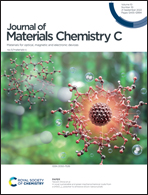A novel sustainable and green mechanochemical route from a (HSiO1.5)n polymer to emissive silicon nanocrystals†
Abstract
Thermal-induced pyrolysis of the hydrogen silsesquioxane ((HSiO1.5)n) polymer has often been applied as a popular straightforward method for the synthesis of silicon nanocrystals (Si NCs), in which the need for high temperature (>1100 °C) and continuous H2 supply during the time-consuming pyrolysis and cooling processes are the main drawbacks. Herein, we offer a sustainable and green alternative to conventional thermal transformations from the (HSiO1.5)n polymer to emissive Si NCs via a room-temperature mechanochemical process with zero H2 supply. Along with the systematic monitoring of the chemical structure change of the (HSiO1.5)n polymer under altered mechanochemical conditions and the detailed characterizations of both solid-state and gas phase products, we derived a novel reaction mechanism from (HSiO1.5)n polymer to Si NCs via a mechanochemical route distinct from conventional thermal pyrolysis. It was found that the in-vessel produced H2via the cleavage of the Si–H bond in (HSiO1.5)n molecule facilitates the generation of Si radicals and formation of resultant Si NCs, while the remaining Si–O–Si network transformed into a SiO2-like matrix through the collapse of the raw (HSiO1.5)n structure and bond redistribution during the mechanochemical process. As a practical application, emissive free-standing Si NCs were successfully prepared via further matrix removal by chemical etching and surface passivation by 1-decene. The prepared Si NCs exhibit photoluminescence in the red-light wavelength region and an absolute quantum yield of 9.8%, whose value is comparable to that synthesized by the conventional thermal pyrolysis method. The novel and facile mechnochemical route developed in the present work opens a new avenue for the smart synthesis of functional nanomaterials.



 Please wait while we load your content...
Please wait while we load your content...